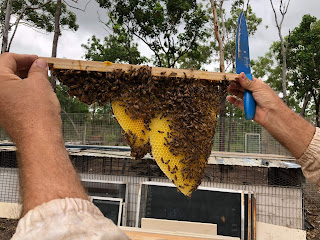The hives have been so quite lately
This due to the cold weather over the last month - well cold for Darwin Australia at least
While those in more northern climates where snow is a common occurrence, we mostly have around 20 degrees at night so it was a significant cold snap for here in the tropics. Each year we might get a week or two where it gets down to 10-12 degrees at night.
But recently, we had one night below 5 degrees Celsius and quite a few 10-15 degrees - temps usually late July, not in June.
Though in the positive it has brought on earlier than normal - the mango tree flowers in abundance

For the last 6 weeks there has been more flowers (not a lot but enough for me to stop substitute feeding) about in the eucalyptus trees - mostly an orange flower and one tall tree with a white. The white one smells deliciously like honey already by itself. You can hear the bees humming amongst particular trees they are focused on - so cool!
These flowers to the right were on ground but the live ones are 20+metres up the trees thus not accessible - well by me anyway - maybe 10 years ago, maybe!
The hive inspection showed bee numbers down a little - usually as I open the hive the ladies rise up to meet me -
In my usually highly active hive - the Grass hive, of the 30 bars in it - I have currently going (was sooooo wanting to split them soon but maybe not!) only 15 of the bars show decent activity and only half of those with significant honey stores and brood.
The Post hive has more honey stores. While the Grass hive has distributed honey to top of comb and brood areas towards the middle and bottom areas of the comb. The Post hive seems to split the comb down the middle with honey on left side and brood on the other. Such a difference in orientation and placement of brood and stores between the hives.
Grass TBH on right, Post TBH comb image on left,
Hoping to have a decent piece of comb of nicely capped honey to enter in the the local show. thinking The post hive will have the best comb - we shall see in two weeks when I have to have it ready for the show. The tiny bit I tasted was awesome! - now just need a good looking piece,
Found the Grass hive post queen which is always exciting
Here is video of her being found
The video is tilted but after trying to put it the right way - the size was better this way.





































